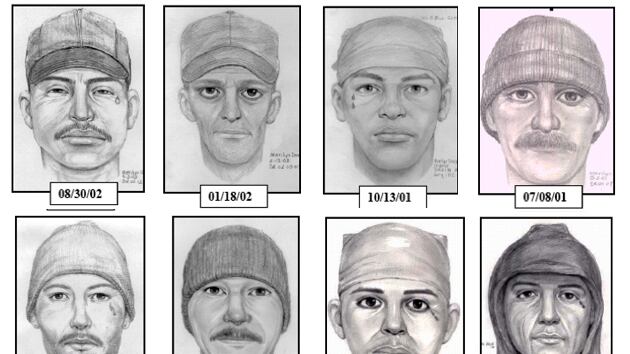For nearly two decades, Los Angeles Police Department detectives have been looking for a serial rapist who is linked to at least 35 sexual assaults. But the department may finally be in reach of cracking the case against the so-called Teardrop Rapist, thanks to a new weapon straight out of Brave New World.
The last known attack by the Teardrop Rapist occurred on June 15, when he approached a 29-year-old woman on her way to work and dragged her into an alleyway. The woman was able to escape before she was raped when a person drove into the alleyway and scared off the attacker. “It shows he is not going away,” says LAPD Det. Sharlene Johnson. “He is still active and will remain active until we get help from the community.”
The rapist has been linked to 10 of his victims through DNA evidence, but police have no idea who he is because he is not in the state and federal Combined DNA Index System, or CODIS. Now, says Johnson, “we are looking into familial DNA testing.”
The LAPD used a “familial search” to catch Lonnie Franklin Jr., suspected of being the Grim Sleeper, one of L.A.’s most notorious and prolific serial killers. Franklin allegedly left his semen and saliva behind on his victims, but there were no matches in CODIS because he was never swabbed for his DNA. But when police searched the database to find a familial match with the Grim Sleeper’s DNA, they hit on Franklin’s then 28-year-old son, Christopher, who was arrested on a weapons charge in the summer of 2009, and had to give up a DNA swab.
Detectives followed Lonnie Franklin to a restaurant, and then acting as waiters surreptitiously collected his cutlery, dishes, and a leftover slice of pizza. Investigators found that DNA evidence taken from the slice of pizza positively matched DNA taken from semen and saliva found on one of the Grim Sleeper’s victims. Franklin was arrested at his home in July 2010 and charged with the murders of 10 women and the attempted murder of another. (The cases were linked through DNA and ballistics evidence). Police believe the tally of potential Grim Sleeper victims is closer to 16. Franklin pleaded not guily to the charges and is currently in a Los Angeles County jail awaiting trial.
Grim Sleeper lead detective Dennis Kilcoyne says the department has used familial DNA searches twice since the Grim Sleeper investigation, but no genetic matches were found. “It is like hitting the lottery,” he says. “We were lucky with Lonnie.” Although familial searching remains controversial, California Attorney General Kamala Harris increased her budget in 2011 to double the number of familial searches to two cases a month. Currently, California, Virginia, and Colorado are the only three states that permit the genetic sleuthing, although there is a push to use the science nationally.

In the Grim Sleeper case, Kilcoyne said the department had to make a formal request to the attorney general’s office, which required among other things a letter signed by then–police chief Bill Bratton and Los Angeles County District Attorney Steve Cooley. The final decision is up to the AG’s office. Kilcoyne said the department has to show that the perpetrator is an “ongoing threat to the public.”
The Teardrop Rapist assaults have mostly occurred while the victims—between the ages of 14 and 41 and all Hispanic, except for two black women—were walking on side streets on their way to work or school in south Los Angeles and Koreatown. In many of the cases, the police said the attacker, who is thought to be in his 40s or early 50s, approached his victims asking for directions or attempting to make small talk, before he pulled out a gun or knife and steered them into a nearby alleyway or yard.
“The MO is so distinct,” says the LAPD’s Johnson. “He is non-threatening at first and doesn’t raise the alarms for these women. I think that is one of the reasons why he is so successful. He appears to be a normal everyday guy on his way to work.”
On Thursday, close to 50 Los Angeles police officers passed out more than 3,500 fliers in south L.A., where police believe the attacker is “geographically linked.” “This individual has a tie to this area,” says LAPD Det. Jesse Alvarado. “He has a relative or a reason to be in this area.”
Alvarado says the police department’s crime-analysis detail came up with the location after they used a computer database to analyze the rapist’s patterns, the location of the attacks, the time of day they occurred, and the ethnicity of the area.
Alvarado says the same type of geographic profiling was used to search for the Grim Sleeper, who police believed lived in the same area where he dumped his victims, mostly poor young African-American women, in alleyways and parks along L.A.’s seedy Western Boulevard. Franklin had been living in the epicenter of the killings since the early ’80s, when he was working as a trash collector for the city’s Department of Sanitation. One of the victims lived less than one block away.
The Teardrop Rapist began his spree in 1996 with the attack of a Hispanic teenage girl. He resumed his attacks in 1999 with the rape of a 13-year-old girl who was abducted in a carport behind an apartment building. That same year, he attacked an 18-year-old woman in Koreatown.
At the time, his victims described him as a 30- to 40-year-old Latino male with brown eyes, brown hair, standing 5-foot-5 to 5-foot-9 and weighing about 150 pounds.
In August 1999, police arrested a 21-year-old man for the attacks, but he was later exonerated through DNA evidence.
More attacks linked to the Teardrop Rapist soon followed. By June 2003, there were 20 similar incidents. Some of his victims reported to police that he had one or more teardrop-shaped tattoos beneath one of his eyes.
At the time, the LAPD appealed for help after a 15-year-old girl was sexually assaulted in the area of Hoover and Gage avenues. The girl described her attacker as wearing a dark hooded sweatshirt, a green bandana, and a black baseball cap or dark-colored beanie to cover his head.
The man took another hiatus before he resumed his spree in 2005. He lay low for six more years before he sexually assaulted a 15-year-old girl as she was walking to school in November 2011. Within weeks of that attack, he was linked by DNA evidence and his “distinct mode of operation” to the other cases.
In April, the LAPD formed a 20-person task force to track down the elusive rapist. As part of their investigation, they began sifting through old robbery and attempted-robbery cases with a sexual component involving female victims. They found six additional cases between the years 1996 and 2003, raising the tally to 34.
“He is a monster,” says LAPD Commander Andrew Smith. “He is ruining people’s lives one at a time.”






